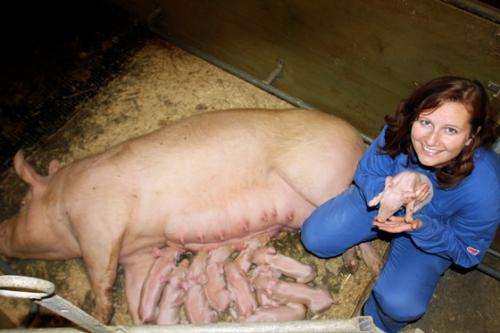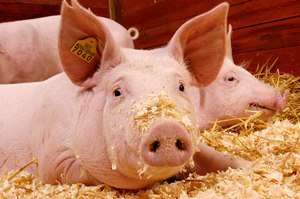The choice of feed, feed strategies have important effects on gilt and sow performance

In her doctoral project, Signe Lovise Thingnes (Norwegian School of Veterinary Science/Norsvin business PhD candidate) used three different methodological approaches in order to investigate how gilts and sows are affected by feed and feed strategy during the breeding, gestation and lactation period. A higher energy content in the feed given to sows in the breeding period and parts of the first pregnancy was shown to give extra body reserves at the onset of breeding and to have a positive effect on life-span and production. During the lactation period, when good feed intake is important for minimising weight loss and loss of condition, free access to feed increased the risk of the sows losing their appetite. The use of pea starch in feed given to lactating sows proved to have a positive effect on the sows' feed intake and condition at the weaning stage.
Breeding based on a long-term and systematic strategy has given Norwegian pig farmers a hybrid sow (Norwegian country pig x Yorkshire) with a good growth potential and high meat percentage. In addition, productivity has increased in terms of larger litters, higher weights at the weaning stage and a larger number of litters per sow per year. This leads to greater demands on the sow and it is therefore important that the feed strategies employed in herds match the production potential of the animals.
Thingnes' first study monitored 500 LY-sows from 25 kg until they were discarded and examined how the distribution of feed with a different energy content during the breeding period and the first stage of pregnancy affected the physical development of the animals and their performance as they produced several litters. A higher energy content in the feed resulted in gilts that were younger and had larger fat reserves at the start of breeding compared to the animals in the control group. Gilts that were given a combination of slightly more energy-rich feed both during the breeding period and parts of the first pregnancy had fewer problems with reproduction and numerically speaking the longest life-span and also produced more piglets throughout their lifetime compared with the other groups being treated.

In the second study, Thingnes investigated whether free access to feed during the last three weeks of the lactation period was a better feed strategy than a strictly controlled increase in feed when it came to the sows' production results and toleration of the physical demands involved. The study showed that free access to feed increases the risk of the sows losing their appetite, and sows that go off their food have a lower feed intake and a higher weight loss. The study also demonstrated that the sow's litter number (age) has an effect on her performance during the lactation period and sows from the first litter had a lower feed intake and a higher risk of losing interest in food.
In the third study, Thingnes looked at whether pea starch is a good alternative to wheat starch in feed for lactating sows as regards their performance during the lactation period. The study showed that sows fed with pea starch had a higher feed intake, a lower weight loss and were in better condition at the weaning stage.
Thingnes' doctoral research was carried out at Norwegian pig farms.
Provided by Norwegian School of Veterinary Science


















